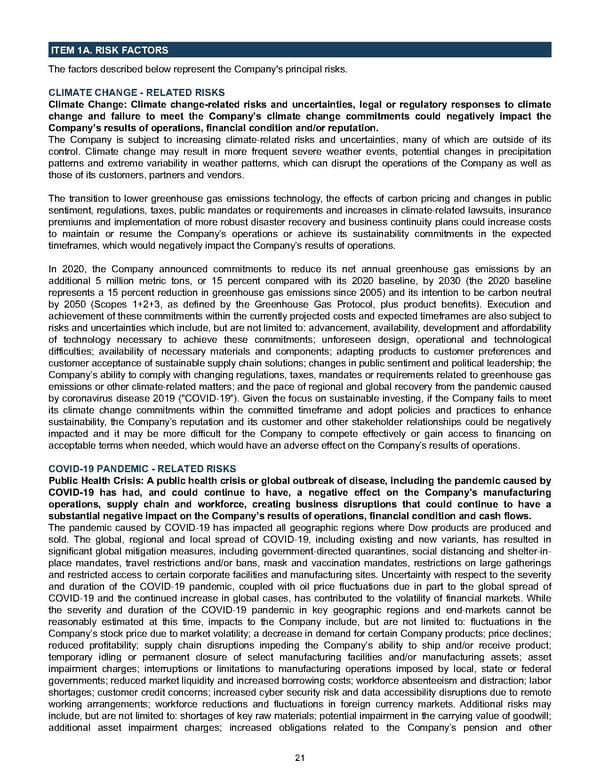ITEM 1A. RISK FACTORS The factors described below represent the Company's principal risks. CLIMATE CHANGE - RELATED RISKS Climate Change: Climate change-related risks and uncertainties, legal or regulatory responses to climate change and failure to meet the Company’s climate change commitments could negatively impact the Company’s results of operations, financial condition and/or reputation. The Company is subject to increasing climate-related risks and uncertainties, many of which are outside of its control. Climate change may result in more frequent severe weather events, potential changes in precipitation patterns and extreme variability in weather patterns, which can disrupt the operations of the Company as well as those of its customers, partners and vendors. The transition to lower greenhouse gas emissions technology, the effects of carbon pricing and changes in public sentiment, regulations, taxes, public mandates or requirements and increases in climate-related lawsuits, insurance premiums and implementation of more robust disaster recovery and business continuity plans could increase costs to maintain or resume the Company’s operations or achieve its sustainability commitments in the expected timeframes, which would negatively impact the Company’s results of operations. In 2020, the Company announced commitments to reduce its net annual greenhouse gas emissions by an additional 5 million metric tons, or 15 percent compared with its 2020 baseline, by 2030 (the 2020 baseline represents a 15 percent reduction in greenhouse gas emissions since 2005) and its intention to be carbon neutral by 2050 (Scopes 1+2+3, as defined by the Greenhouse Gas Protocol, plus product benefits). Execution and achievement of these commitments within the currently projected costs and expected timeframes are also subject to risks and uncertainties which include, but are not limited to: advancement, availability, development and affordability of technology necessary to achieve these commitments; unforeseen design, operational and technological difficulties; availability of necessary materials and components; adapting products to customer preferences and customer acceptance of sustainable supply chain solutions; changes in public sentiment and political leadership; the Company’s ability to comply with changing regulations, taxes, mandates or requirements related to greenhouse gas emissions or other climate-related matters; and the pace of regional and global recovery from the pandemic caused by coronavirus disease 2019 ("COVID-19"). Given the focus on sustainable investing, if the Company fails to meet its climate change commitments within the committed timeframe and adopt policies and practices to enhance sustainability, the Company’s reputation and its customer and other stakeholder relationships could be negatively impacted and it may be more difficult for the Company to compete effectively or gain access to financing on acceptable terms when needed, which would have an adverse effect on the Company’s results of operations. COVID-19 PANDEMIC - RELATED RISKS Public Health Crisis: A public health crisis or global outbreak of disease, including the pandemic caused by COVID-19 has had, and could continue to have, a negative effect on the Company's manufacturing operations, supply chain and workforce, creating business disruptions that could continue to have a substantial negative impact on the Company’s results of operations, financial condition and cash flows. The pandemic caused by COVID-19 has impacted all geographic regions where Dow products are produced and sold. The global, regional and local spread of COVID-19, including existing and new variants, has resulted in significant global mitigation measures, including government-directed quarantines, social distancing and shelter-in- place mandates, travel restrictions and/or bans, mask and vaccination mandates, restrictions on large gatherings and restricted access to certain corporate facilities and manufacturing sites. Uncertainty with respect to the severity and duration of the COVID-19 pandemic, coupled with oil price fluctuations due in part to the global spread of COVID-19 and the continued increase in global cases, has contributed to the volatility of financial markets. While the severity and duration of the COVID-19 pandemic in key geographic regions and end-markets cannot be reasonably estimated at this time, impacts to the Company include, but are not limited to: fluctuations in the Company’s stock price due to market volatility; a decrease in demand for certain Company products; price declines; reduced profitability; supply chain disruptions impeding the Company’s ability to ship and/or receive product; temporary idling or permanent closure of select manufacturing facilities and/or manufacturing assets; asset impairment charges; interruptions or limitations to manufacturing operations imposed by local, state or federal governments; reduced market liquidity and increased borrowing costs; workforce absenteeism and distraction; labor shortages; customer credit concerns; increased cyber security risk and data accessibility disruptions due to remote working arrangements; workforce reductions and fluctuations in foreign currency markets. Additional risks may include, but are not limited to: shortages of key raw materials; potential impairment in the carrying value of goodwill; additional asset impairment charges; increased obligations related to the Company’s pension and other 21
 Annual Report Page 30 Page 32
Annual Report Page 30 Page 32